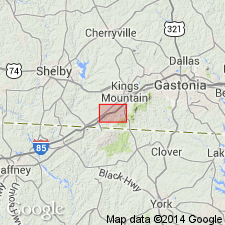
- Usage in publication:
-
- Gaffney marble*
- Modifications:
-
- Original reference
- Dominant lithology:
-
- Marble
- AAPG geologic province:
-
- Piedmont-Blue Ridge province
Summary:
Pg. 28, 72-75. Gaffney marble. A rather variable formation ranging from very fine to medium fine-grained marble, and from bluish gray to white in color. Most of it has a schistose or banded structure, made more evident by presence of impurities, such as mica and hornblende. In some places the marble is highly magnesian. Thickness 30 to 300 feet. Overlies Blacksburg schist. Is of Cambrian age, probably Early Cambrian.
[Named from exposures at Gaffney, Cherokee Co., northwestern SC. Extends into southern NC.]
Source: US geologic names lexicon (USGS Bull. 896, p. 789).

- Usage in publication:
-
- Gaffney [formation]
- Modifications:
-
- Areal extent
- AAPG geologic province:
-
- Piedmont-Blue Ridge province
Summary:
Pg. 756, 764, 776, 780. Gaffney [formation]. The quartzite, carbonate-silicate rocks, and crystalline limestone have been mapped as Cambrian (the Kings Mountain, Blacksburg, and Gaffney formations). Near Kings Mountain, mica schist and gneisses previously mapped as Carolina gneiss, and hornblende gneisses previously mapped as Roan gneiss actually constitute the metamorphosed upper part of the Gaffney; names Carolina and Roan, therefore, have lithologic but not stratigraphic significance.
[GNC remark (ca. 1960, US geologic names lexicon, USGS Bull. 1200, p. 1450): The USGS currently designates the age of the Gaffney marble as Mississippian on the basis of a study now in progress. (See Overstreet and Bell, 1965.)]
Source: US geologic names lexicon (USGS Bull. 1200, p. 1450).

- Usage in publication:
-
- Gaffney Marble*
- Modifications:
-
- Age modified
- Geochronologic dating
- AAPG geologic province:
-
- Piedmont-Blue Ridge province
Summary:
Pg. 48-50, 89 (geol. time scale), 98 (table 9), 108-109. Gaffney Marble. Age changed from Cambrian(?) --to-- Mississippian on basis of Lead-alpha age determination. (Authors follow revised time scale of Holmes, 1959, Edinburgh Geol. Soc. Trans., v. 17, pt. 3, p. 183-216.)
Source: Publication; Changes in stratigraphic nomenclature, 1964 (USGS Bull. 1224-A, p. A18).

- Usage in publication:
-
- Gaffney Marble Member*
- Modifications:
-
- Revised
- AAPG geologic province:
-
- Piedmont-Blue Ridge province
Summary:
Gaffney Marble is reduced in rank to Gaffney Marble Member of Blacksburg Formation and restricted to the marble unit that crops out on the east side of Gaffney, SC. It appears to be locally dismembered and repeated by faulting. Age assumed to be Late Proterozoic(?). Other marble occurrences in the Blacksburg may or may not be equivalent. Informal Dixon Branch marble member of Blacksburg may be Gaffney repeated by faulting.
Source: GNU records (USGS DDS-6; Reston GNULEX).
For more information, please contact Nancy Stamm, Geologic Names Committee Secretary.
Asterisk (*) indicates published by U.S. Geological Survey authors.
"No current usage" (†) implies that a name has been abandoned or has fallen into disuse. Former usage and, if known, replacement name given in parentheses ( ).
Slash (/) indicates name conflicts with nomenclatural guidelines (CSN, 1933; ACSN, 1961, 1970; NACSN, 1983, 2005, 2021). May be explained within brackets ([ ]).

